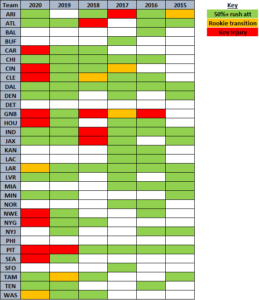The end of 2020 saw a twitter explosion of ‘I told you so’ from Zero-RB truthers as we saw four of the first 12 RBs drafted miss large parts of the season through injury (CMC, Saquon, Mixon, Ekeler) and others struggling to impose themselves on their opponents (Zeke, Drake).
If I was going to be awkward and argumentative about it I would mention Michael Thomas, Julio Jones and George Kittle in response, but I’m not going to do that…
In fact, I’m not here to get in to a zero-RB debate. However, I might just pick on a few things that help the arguments for some of those mass-debaters…what?!.
What I am going to look at is RBBC (Running Back By Committee). My working theory at the start of this process is that there are less workhorse backs taking a majority of touches for their team than in previous seasons and that RBBC is on the increase.
High Touch Running Backs
Lets start with some arbitrary thresholds and look at how many running backs have had 200+ carries and how many have 175+ carries.
In 2016, 19 RBs had 200+ carries and 23 had 175+
In 2017, 18 and 26
2018, 14 and 20
2019, 20 and 22
In 2020, 10 and 17
Ok, that’s a good start to support the theory, there were definitely less of the high-carry running backs in 2020 than in previous years.
What’s that I hear you say? We need to include pass-catching as part of the volume comparisons? Ok, lets look at total opportunities (carries + targets) and use a threshold of 250+
2016 = 18
2017 = 13
2018 = 12
2019 = 20
2020 = 11
It’s a similar deal here but I am starting to see something else of note. The drop off in touches from 2019 to 2020 is significant but that’s not all on 2020, 2019 was a particularly high year so the drop off looks far worse than it actually should be.
And I have no doubt that this high volume production in 2019 was a large factor in reaching for running backs in the first and second rounds of 2020 drafts.
Touch Thresholds
So what are the touch thresholds that we need to know? I looked at how many running backs got a certain percentage of a team’s carries:
Firstly, looking at running back carries only, you can see from the above table that the number of 90-percent plus and 80-percent plus backs has been relatively stable (although, look again at that 2019 spike). Similarly, when you go all the way down to the 50-percent plus range there’s not too much change.
However, when you look at 70-percent plus and 60-percent plus, the change is noticeable. There’s a definite reduction in the number of backs with this level of volume but once again, it’s exacerbated by a huge spike in 2019.
As I worked through this I couldn’t help but think about all of the mobile Quarterbacks taking team carries so I ran the same process but with team total rush attempts as the base, not just running back rush attempts.
As you can see, this bumps everything down a couple of categories and no running back in the last six years has had more than 80-percent of their team carries. 70-percent plus is fairly stable, there’s a small drop off at the 60-percent category and a huge drop at 50-percent plus. You can write the next sentence of this by now…yep, look at that 2019 spike.
And looking at total opportunities (carries + targets):

Again, a small drop in one category but really not that far off in the grand scheme of things.
2020 is definitely down but when you look at 2018 levels, it’s not far off. This then, becomes a look in to 2019 and it led me to a couple of questions
What was different in 2019 and was this the outlier that overly-influenced our 2020 drafts?
I’m looking at the category with the biggest difference – players with 50-percent or more of their team’s total rushing attempts (not just RB touches), and have looked at which teams have had a player in this category for each of the years from 2015 to 2020.
There’s a few interesting takeaways:
- Through 2015 to 2017, there’s a lot of classic OG running back types. Frank Gore, Doug Martin, Adrian Peterson, Jay Ajayi, Jordan Howard, LeGarette Blount, Matt Forte, Mark Ingram, Latavius Murray, LeSean McCoy, Carlos Hyde, Marshawn Lynch
- We also saw a number of teams attempt to find their workhorse, giving one guy most of the touches for a season but then moving on when it was apparent it wasn’t going to work. Baltimore (Terrance West), Denver (Ronnie Hillman, CJ Anderson), Jacksonville (TJ Yeldon)
- As we moved through 2017, 2018 and 2019 there were some good rookie running backs who transitioned in to their roles over that period. Joe Mixon (drafted in 2017, took the workload in 2018), Nick Chubb (drafted in 2018, took the workload in 2019), Ronald Jones (drafted in 2018, took the workload in 2020). So this meant we had a number of teams through each year that didn’t have the dominant back as they were bringing through the new blood. Looking at the picture as a whole, this definitely feels like a shift from the OGs in item 1 through to the new age
So if the last three to four years has been that transition, why the spike in 2019?
Injuries.
In 2018 Atlanta, Green Bay, Indianapolis and Jacksonville all had key injuries to their main man. Add in the Nick Chubb settling-in period in Cleveland and there’s five teams that would otherwise have boosted the 2018 number.
In 2020 we can include Carolina, Cincinnati, Cleveland, Green Bay, Houston, New England, New York Giants and Seattle on this list. That’s the biggest list of key injuries to running backs during the ‘new age’ so it’s no wonder the 2020 number is down.
In 2019, the year we saw a spike, Pittsburgh (James Conner) was the only team to suffer this fate and Tampa Bay (Ronald Jones) was the only team transitioning in their ‘rookie’ running back (yes I know he wasn’t technically a rookie but the Buccaneers developed his year two in a way most teams do in year one).
So are we really transitioning to less workhorse backs and more RBBC?
No we’re not. We’re just seeing a flip in fortune from the least injury-impacted year for some time in 2019, to the most impacted in 2020. And from a year where only one ‘workhorse’ team was settling in their new blood in 2019 (Tampa Bay) to one where three were being settled in (Indianapolis, Los Angeles Rams, and Washington are all coming off multiple seasons with a dominant back prior to drafting a rookie back in 2020).
What does this mean for 2021?
Well the 2021 draft and free agency are going to play a huge part in what 2021 is going to look like. But if we assume for a moment that only the teams who haven’t had a dominant back in 2020 are affected then there is a plentiful bounty of teams with a clear RB1 to look at in 2021.
Arizona, Carolina, Chicago, Cincinnati, Cleveland, Dallas, Green Bay, Houston, Indianapolis, Jacksonville, Los Angeles Rams, Las Vegas, Minnesota, New York Giants, Seattle, Tampa Bay, Tennessee and Washington are all there for the taking should their front offices and coaches make it so.
Elite Backs
Of course we shouldn’t forget about the Elite tier of this group. The guys who creep in to those red areas of our tables above, getting more than 70-percent of team rush attempts or more than 40-percent of total opportunities.
Derrick Henry, Dalvin Cook and James Robinson were those guys in 2020; McCaffrey, Chubb and Mixon in 2019; and Barkley, Elliott and David Johnson in 2018.
This is the early round-one pick if you can identify who it’s going to be. But do you see what I see? From 2015 to 2020, no player has landed in either of these categories for two straight years… just saying…







